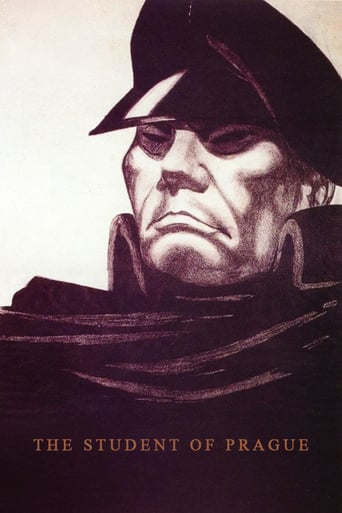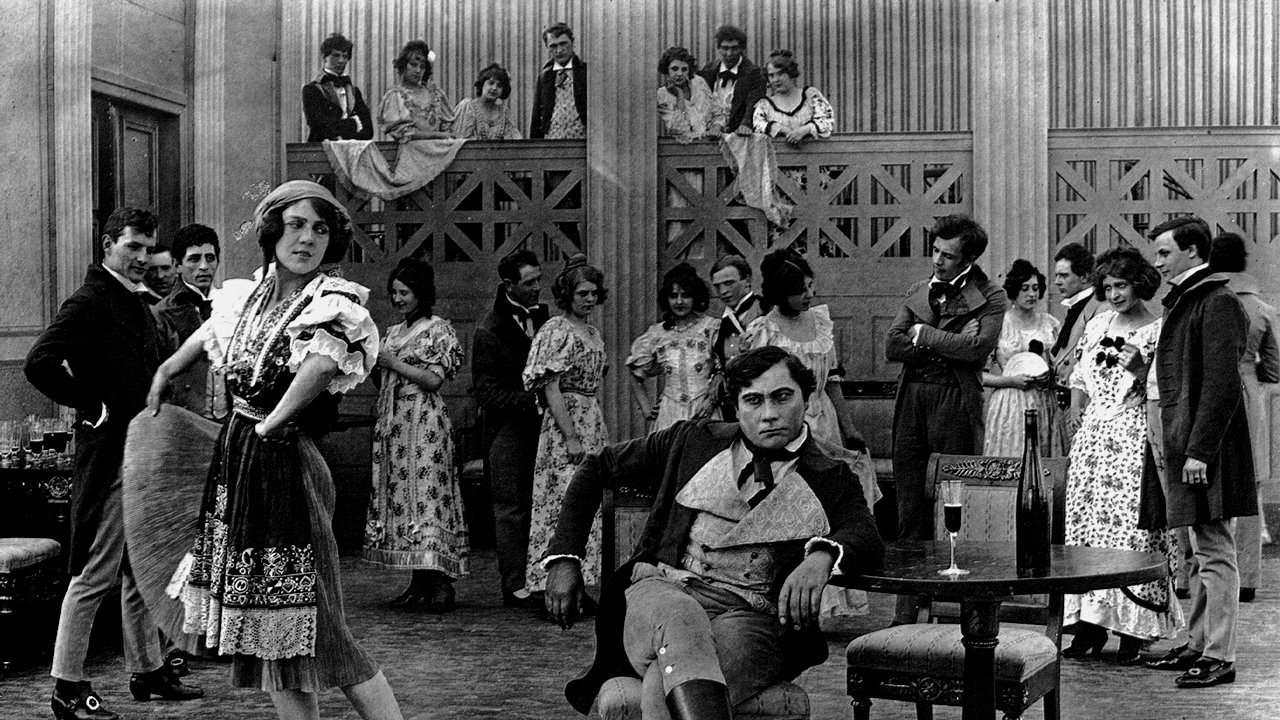Horst in Translation (filmreviews@web.de)
"Der Student von Prag" or "The Student of Prague" is a German black-and-white silent film from 1913, so this one is already clearly over a 100 years old. Do not be fooled by soundtracks that were added later on, this is not a sound movie. The writer and director here is Hanns Heinz Ewers and this is probably his most known work. He is not even close to being as famous as the likes of Murnau or even Lang, but it looks like he was there before them already. Unfortunately, I cannot praise his work here. It is based on a work by Edgar Allen Poe and, like so many other films, includes many references on Goethe's "Faust", when a young man makes a deal with somebody he should have stayed far far away. And, of course, the deal is about a woman.The movie runs for slightly over 80 minutes, at least in the version I saw, but I see that there are several way shorter versions out there too. Your choice which one to watch. I personally would recommend one of the shorter as I felt this film did not only drag on several occasions despite under 90 minutes runtime, but it also clearly lacked intertitles and would have needed many many more of these to be a rewarding watch, but also to actually let the audience understand what is going on. I had a question mark above my head for a large part of the film and this may be a reason why I lost interest quickly and give this one a thumbs down. Not recommended.
didi-5
This early version of the tale 'The Student of Prague' was made in Germany in 1913, starring Paul Wegener (who was also in 'The Golem' a few years later). In this film he plays a dual role (technically impressive for a 95 year old film to see them in the same shot) after meeting a mysterious old man who makes a pact with him for gold - the gold he needs to woo a countess he's previously saved from drowning.Moving at a fast pace (the film runs just over an hour) and fairly well written and characterised, 'The Student of Prague' has echoes of the Faust legend as well as Dr Jekyll and Mr Hyde, starting as it does with a pact with a mysterious figure of potential evil, and developing into good and evil sides of the same person.
José Luis Rivera Mendoza (jluis1984)
One of the most important artistic movements in the history of cinema was without a doubt German expressionism, the highly atmospheric style of film-making developed during the 20s in Berlin. Classic movies like "Das Cabinet Des Dr. Caligari." (1920) and "Nosferatu, Eine Symphonie Des Grauens" (1922) were the most famous direct results of this movement, and while the movement didn't have a long life, its enormous influence over cinema can still be felt today, specially in the horror genre. One of the key figures of this style would be director Paul Wegener, director of 1920's "Der Golem, Wie Er in die Welt Kam", as in his debut as a filmmaker, seven years before the making of that classic, he was already making experiments with expressionism in film. That early prototype of German expressionism was incidentally, another horror film: "Der Student Von Prag"."Der Student Von Prag" ("The Student of Prague"), is the story of Balduin (Paul Wegener), a student with the reputation of being the best fencer in Prague, but who always find himself with financial troubles. One day, Balduin rescues the beautiful countess Margit (Grete Berger) from drowning in a lake after her horse drop her by accident. Balduin falls immediately in love with her and tries to see her again, but soon he discovers that he'll have to compete with her rich cousin, Graf Von Schwarzenberg (Lothar Körner), who also wants to marry her. Knowing that he can't offer her much, Balduin wishes to be wealthy, and this is where a sorcerer named Scapinelli (John Gottowt) enters the scene. Scapinelli offers Balduin infinite wealth in exchange of whatever he finds in his room. Balduin accepts the proposal, only to discover in horror that what Scapinelli wants is his reflection in the mirror.Loosely inspired by Edgar Allan Poe's short story "William Wilson" and the classic legend of "Faust", the story of "Der Student Von Prag" was conceived by German writer Hanns Heinz Ewers, a master of horror literature and one of the first writers to consider scriptwriting as valid as any other form of literature. Written at a time where cinema in Germany was still being developed as an art form, "Der Student Von Prag" shows a real willingness to actually use cinema to tell a fully developed story beyond a camera trick or a series of scenes. Like most of the scriptwriters of his time, Ewers screenplay is still very influenced by theater, although "Der Student Von Prag" begins to move away from that style. While a bit poor on its character development (specially on the supporting characters), Ewers manages to create an interesting and complex protagonist in the person of Balduin.While "Der Student Von Prag" was Paul Wegener's directorial debut and Stellan Rye's second film as a filmmaker, it's very clear that these two pioneers had a very good idea of what cinema could do when done properly. Giving great use to Guido Seeber's cinematography, the two young filmmakers create a powerful Gothic atmosphere that forecasts what the German filmmakers of the following decade would do. Wegener would learn many of the techniques he would employ in his "Golem" series from Seeber and Rye. Despite having very limited resources, Rye and Wegener manage to create an amazing and very convincing (for its time) visual effect for the scenes with Balduin's reflection (played by Wegener too). Already an experienced stage actor at the time of making this film, Wegener directs the cast with great talent and also attempts to move away from the stagy style of previous filmmakers.As Balduin, Paul Wegener is very effective and probably the best in the movie. It certainly helps that his character is the only one fully developed by the writer, but one can't deny that Wegener was very good in his role as the poor student who loses more than his mirror reflection in that contract. John Gottowt plays the sinister Scapinelli with mysterious aura that suits the character like a glove. Few is said about Scapinelli in the film, but Gottowt makes sure to let us know that he is a force to be feared. The rest of the main cast is less lucky, with Grete Berger being pretty much average as countess Margit, and Lothar Körner making a poor Graf Von Schwarzenberg. However, it must be said that Lyda Salmonova was pretty good in her expressive character and Fritz Weidemann made an excellent Baron Waldis-Schwarzenberg, showing the dignity that Lörner's character should have had.Considering the movies that were being done in those years in other countries and the fact that its remake (made 13 years after this film) is superior in every possible way, it's not difficult to understand why "Der Student Von Prag" hasn't stood the test of time as well as other early films. The movie's main problem is definitely its extremely low budget, as it resulted in the film being considerably shorter than what Ewers' story needed to be fully developed. This makes the plot feel a bit too vague at times, or even incomplete, as if there was something missing in the narrative (of course, there's also the possibility that the existing print is really incomplete). However, "Der Student Von Prag" is a very interesting early attempt at a complex tale of horror and suspense in film that, while inferior to what other filmmakers were doing at the time, left a powerful impression in history.As the direct predecessor of the German expressionist movement, it's hard to deny the enormous importance that "Der Student Von Prag" has in the history of German cinema, probably in the history of cinema in general. It may look dated even for its time, but considering the limited resources its director had, it's truly better than most films from that era. As the movie that started Paul Wegener's career, and with that German expressionism, "Der Student Von Prag" is a must see for everyone interested in this slice of film history. 7/10
MARIO GAUCI
This film marks the beginning of the Golden Age of Silent Horror movies emanating from Germany, though its style is not yet what would come to be defined "Expressionist". I had watched it many years ago on Italian TV and remember liking it quite a bit though, in retrospect, it suffers in comparison with the superior 1926 remake (not least because that one is more than twice its length!); it's still well worth watching and remains full of interest today, also because it led directly to Paul Wegener's trademark role of The Golem in a famous trilogy, which unfortunately is almost impossible to re-evaluate today since only the third entry in the series seems to have survived! The accompanying synthesizer score on the Alpha DVD was quite unnerving in its relentless repetitiveness which, in hindsight, perfectly suited the doppelganger theme of the movie.


 AD
AD




